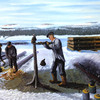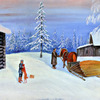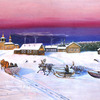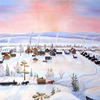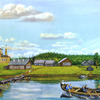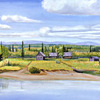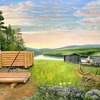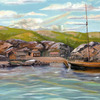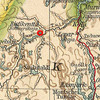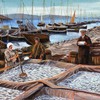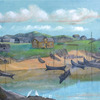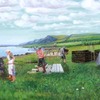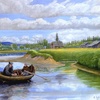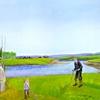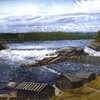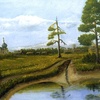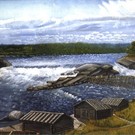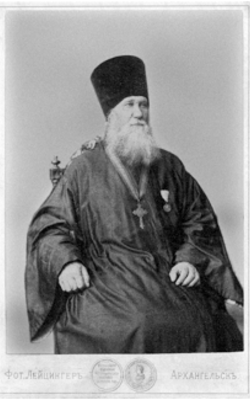Ristikent
Most of the geographical names in the Kola Peninsula have Sami/Lapp and Finnish origins. The cartographers, when faced with difficult local names, tried to make them sound more Russian. Many of the places are now called differently: Nuorttijarvi – Nota Lake – Notozero, Nuortiijoki – Note River, Tuulomojoki – River Tuloma, Luttojoki – River Lotta, Jurki – Jukino, Ristikentta –Restikent-Ristikent.
As far as the tymology of the word Ristikenta is concerned, the first part of it “Risti” in Nota Lake dialect of Scolt-Sami language means Christ or crucifix and in Finnish it means the crucifix, but the second part is derivative of the verb “to convert”, which is retained in northern Sami as a genndot, in Scolt-Sami it must had been Kennta. In Finnish it is “Kenta”, which means place or meadow.
This denoted the place, where the Sami people were converted to Christianity!
From a descendant of the ancient Lapp family of Nota settlement, Anfisa Ivanovna Gerasimova (1924-2006); who was born in a farm house near Koskjaur, and then lived at a farm near settlement of Ystie Lotta, and who lived her final years in the toan of Upper-Tuloms (Verkhnytulomsky); we came to know that the word Ristikantta (Ristikent) in Scolt-Sami language (Scolt including the Nota Lake dialect) means the “Christ’s place”. This is also confirmed by the still living Lapp Gerasimov Alexander Ivanovich, who was born and raised in Ristikent.
In the times of colonisation of the Kola Peninsula and christening of the Lapps by the first of the Orthodox monks missionaries (St. Fedorit, St. Triphon etc.), which started in 1540, the Orthodox roadside crucifix was installed in a scenic location at the inrtersection of the two road, which went around the Nota Lake from both sides, at the foot of the Vertishvar Hill. Initially the Nota Lake Lapps were considered as parishners of the Kola cathedral, but in 1862 an independent parish was created. The construction of the Nota Lake church started in 1866, with an amount of 1782 roubles 41 kopeck, assigned for the purpose by the Holy Synod. The new wooden Orthodox Church, with dome and cross, was commissioned on 17 December 1870 in honour of the Baptism of our Lord Jesus Christ. The local Lapp Anisim Moshnikov was the church elder since 1877. V. I. Nemirovich-Danchenko mentioned this church in the same year, 1877, in his book “The cold c country”: “We spent the whole day on the cliffs, which encompass the Tuloma waterfall. In the morning accompanied by the local Lapps we went salmon fishing downstream. At non we were treated to lunch, which comprised of the irreplaceable salmon, its caviar and grayling, fried in own juices. Only in the evening could we take leave of the hospitable fishermen, but when we went into the forest, which we had to cross to get to the Notak Lake church, it was already night”…”In the Nota Lake, at the head of the Tuloma River, there is an island, which was given to the clergy of the local church. The Lapps build a salmon fence for him from the island to the lake shore, every year. On top of that the clergy was also endowed with the Lakhta, some 80+ miles from the Tuloma waterfall (the “teschin bay” rapid). During the spring overflow there is a lot of salmon and other fish in it. When the water levels go down, the salmon remains in this natural lake. People use drift nets to fish in these places. There can be such episodes as well: “Men are sitting on the river banks with their tackle and fishing the passing salmon, grabbing it from the gills”. This simple fishing technique requires experience and agility. It is also fished in the Lakhta during overflow, when it is forced by the Tuloma into the clergy’s fence and goes through the whole of Nota Lake into the Nota River, where after spawning it loses weight and becomes an easy prey. The Finns and Swedes fish it there. The catch in the whole of Nota Lake, the Tuloma River and its tributaries is owned by the Nota Lake and Songelsk settlements. Apart from salmon the Nota Lake also offers a good catch of whitefish, grayling, pike and perch.
I personally inspected the salmon fence of the clergy of the Nota Lake church. It is not very big, but during good times you get around 200 stones of fish in it. Only once was the catch for the summer greater than 300 stones… The island itself is very beautiful and the scenic landscape all around makes it even more attractive. We passed a whole day there. I was amazed by the large numbers of hazel grouse in the surrounding planes.
Father Georgy Terentiev, who left fond memories of himself, was a staunch defender of the Lappish rights and he introduced the people of the Nota Lake area to gardening (vege growing). Here in the middle of Lapland, he and subsequently the Lapps started growing potatoes, radish and horse radish. The harvest was good. They also tried to grow cabbage. The leaves were of good size, but they would not close. He also acclimatized corn successfully, but he was soon transferred to the Kola cathedral, so the generous effort just died in the primary stage, without yielding any results. Father Georgy Terentiev was replaced by some old, sick and paralyzed priest, whose wife was accused of misappropriation of church’s funds by the local Lappish elders. It is obvious that such people could not continue the work started by father Terentiev. So you can say that all the seeds of civilization died before growing taller. With this the gardening effort was killed, the cattle was consumed and the settled lifestyle was lost!
I still cannot help forget the lost look on the face of the Nota Lake church’s elder, when he told me about the poverty of their settlement (tribe). He sounded so desperate and had no belief in better times ahead. Probably, despite all the abundance of fish and hunt in the area, the people are forced to survive on what they can find and wherever they can.
By the way it is important here to explain the understanding of the word POGOST (settlement) for the Lapps. This is not a place, where the Lapps live around the church. And it is not the Lappish village, town, winter camping grounds, where they returned from the grazing fields to their native Pogost around Christmas time and passed the harsh winters there in their wood log houses. They Lapps would live at their winter settlements from 25 December till 23rd of April and then they would again part ways to go to various familial estates, within the boundaries of their pogost (tribal area), depending on the migratory pattern of reindeer over the grazing fields and availability of fish in the rivers, switching their home 4 times a year. At the summer camping grounds the Lapps would live in huts, whereas in winter they pitched tents (Lavvu).
“Despite the nomadic lifestyle, which forces most of the Lapps to migrate from the winter camping grounds, often long before the start of fishing season, during spring, to the river banks, in summer to the shores of large lakes or the sea and in fall again somewhere, where they could find sweet water, the Lapps very rarely went beyond the boundaries of their tribal lands (pogost) (of course these boundaries are very approximate), and that would only happen, when looking for stray or lost reindeer, which would had the owner’s seal (tamgha) on it.
By that time there were a few ethnic groups of native people – Lapps – in the Kola (Russian) Lapland. Their ancestry traced back thousands of years. All the hunting grounds, fishing areas, reindeer grazing fields were assigned to families and were inherited by each following generation. The family needed large estates to be able to feed itself. Such territories, assigned to Lappish families of a single origin (tribal origin), were called the pogost (sijjt).
According to historical data in 1772 there were 27 Lappish pogosts and in 1859 they were reduced to only 18.
In 1877 the whole Russian Lapland (Kola Peninsula) was divided among ten or twelve pogosts, which were grouped into three agricultural communes: Voronezh, Ek-Ostrov and Pechanga, forming a single district – Kola-Lappish.
In the Nota Lake basin there were two large Lappish pogosts called Songelsk and Nota Lake pogosts, which were considered to the be the poorest.
The center of the Songelsk pogost on the territory of the River Nota basin was the ancient Lappish winter camping grounds of Songelsk. It was situated some 85km away from the former settlement of Ristikent above theKatskin Lake. The River Katskim ran from the Katskim Lake to the River Nota. The toponyms mean that the beds of both the river and the Katskim Lake were snaggy (Katskes – in Lappish).
The Songelsk settlement was populated by 7 of the ancient Lappish families: Gavrilovs, Kiprijanovs, Pyanois, Stepanovs, Sverdlovs, Fedotovs, Feofanovs, who had their own seal for their reindeers. Each of the families had their estates within the boundaries of the pogost.
Part of the Songelsk Lapps were christened on their native lands near the Alla-Akkjarvi Lake, where back then they had one of their winter camping grounds, which was later renamed as Ristomen-sijjt, i.e. Christian pogost.
5 of the ancient Lappish families, with their own personalized seals, constituted the Nota Lake pogost (sijjt) in the Nota Lake basin (Rivers Lotta, Nota, Tuloma, Petcha, Konja etc.) with winter camping grounds of Lotta outfall, Ristikent, Kentishi, Padun etc.: Gerasimovs, Moshnikovs, Osipovs, Glukhis, Titovs.
There is a holy place, near the Padun waterfall, opposite to the ancient Padun camping grounds, on the opposite bank of the River Tuloma – the ancient Lappish graveyard called “Nuorttijarvi”, where a church was built in the beginning of the 20th century. Later the church was used as a club. Currently the building is deserted and stands in a very rotten condition. This partly because the locals fear the said place, since they still remember the following legend: “After his death evil Noida (Lappish shaman) could have turned into a vampire (in Lappish – “ravk”). When Noida Riz died the Lapps were afraid to bury him. Only another Noida volunteered. He saddled his sleigh, placed the dead body in a coffin and took it to the graveyard. On the way, at midnight the deceased sat-up in the coffin, but after the Noida’s chanting again lied down. After a short time he again rose. At this moment the Noida committed an unforgivable for the shaman error: he threatened the vampire with a knife (he needed to just use a stick to scare it), - the deceased again lied down, but in the shrouded taiga, it became clear under the moonlight that the deceased’s teeth turned into steel. The Noida understood his mistake and understood that he was not strong enough to tackle the situation, so he ran to safety climbing up a tall fir tree. The vampire got out of the coffin and very slowly came up to the tree. Placing his hands on his chest he started biting off the fir tree. The trunk was just about chewed out, when the break of dawn saved the Noida from imminent death – with the first rays of daylight the vampire again went to the coffin. The Noida, obviously being a weak shaman, buried the vampire lying sideways in the coffin, however, it was well known that he had to place the body face down, to make sure that the vampire would not be able to get out of the grave. The Noida’s mistake resulted in the vampire escaping the grave in the nights and following people. For example, once young men while passing by Riz’s grave, frivolously said: “He was a great Noida, but this is where he ended up”. Just a little while later the ground shook – the vampire escaped the grave to get to the passers-by. Hearing someone following them they gathered an aspen stake and started drawing crucifixes on the ground. The vampire was forced to waste time on bypassing the crosses, which gave the Lapps sufficient time to run out to the River Tuloma (exactly to the place where the Upper-Tuloma village stands now) and escaped the claws of the vampire taking the boat”.
The Finns started colonizing the banks of Murman in the middle of XIX century. The cause for this colonization was the famine in Finland.
Yes and Russia also needed to take hold of the northern lands, since Norway and Sweden were also eager to annex these free lands. Therefore, the Russian emperors, starting from Alexander I, did everything they could to populate these lands with their subjects. The state even gave lucrative loans to settlers for initial expenses – 300 roubles; for example the milking cow was worth only 10 roubles. There was an abundance of fowl and fish, with even the salmon rising into the River Nota and its tributaries for spawning. The settlers cultivated barley, potatoes and radish, which gave good crops.
Following the flow of settlers form Finland and Russia, in the very beginning of the XX century, near the Nota Lake church on the Lappish winter camping grounds grew the settlement of Ristikent (Ristikenttä).
“Carel Nikanor Kostyliev with the forest commissioner’s permission built a home near it. After attaining the necessary documents, Nikanor became the second inhabitant of the future village… Then came Juho Kallio and others. In 1916 the old wood log church was replaced by a stone structure with a bell-tower (with three bells).
By 1920 the village of Ristikent has around 20 homes. More than half of the people in the village were Finns. The villagers mainly engaged in fishing and cattle farming. Some of them also engaged in timber making and trade”. Downstream from the church, on the bank of the Lake they built a dock and in the bay they imbued pine logs.
Spring and summer of 1921 were the end for many of the inhabitants of the Nota and Tuloma River basins. The Spanish flue and smallpox killed complete families.
Most of the Skolt Lapps, before the war, when the boundaries were retraced and their lands were annexed by the USSR, shifted to Finland to the Province of Inari, where about 300 of them still live, with many of them still speaking in the Nota Lake dialect (Skolt). However, in Russia there are very few people left who speak the Skolt language and more so nearly all of them speak it at a low level. The only person, who speaks good Nota Lake dialect of this “dying” language is Gerasimov Alexander Ivanovich. He lives in the Upper-Tuloma village.
All the information, which we have about the history of the areas in and around the Ristikent settlement in the XX century, reached us thanks to the famous resident of the Upper-Tuloma village, Sven Petrovich Lokko (1924-2008), who was a Finn – writer, member of the writers’ union since 1990, publicist and artist. Thanks to his paintings and trilogy “Finns in the Murman”, we can now understand how more than 100 years ago the Finns colonized the native Lapland, crossing the arbitrary state line near the Javr Lake area, and what happened to them later on.
Before the revolution the banks and tributaries of the River Tuloma underwent heavy deforestation. The main areas of deforestation: Ristikent, Murmashi, Ulita, Petcha, Kuklino. The lumber was then sent to Drovyan, where they had a mechanized sawmill, owned by a Swede. During the Soviet era the state took over the timber business. During this period the Finnish settlers were able to find work at the timber factories.
“The Finns, from the very beginning of settling in the Lappish lands, with their natural fervor and love for hard work, grew roots in the rocky territory. They very actively settled down, contrary to the liking of the locals – Lapps, who were used to a slow pace of life in harmony with the nature and being accustomed to tough Northern conditions. The Finnish aggression also scared the peaceful and simple Lapps. Their verbal history includes tales of Germans coming to the area for looting”.
This is how Sven Lokko described it all in his book “The Finns in Murman”. The Finns populated the banks of the rivers in separate hamlets. They harvested the lands, grew barley, oatmeal, raised cattle and fished.
The Nota Lake was populated by aborigine Stepan Osipov (5 sons), Lapps Ivan and Anisim Moshnikov, Timofei Moshnikov and Evdokim Titov.
The ancient Lappish camping ground of Padun was located deep in the forest, so that the invaders floating up or down the river could not see it. In 1916 a 4 level school was opened in this settlement.
The Finns also lived on the banks of Tuloma, in hamlets: “The hamlets were owned by the families of Venjama Lokko, Juho Tsukanen, Arvid Heglund, KalleKaulanen etc.
The problems related to the relations among different groups of people were decided mainly according to the communist party’s “line” of action, under the government’s orders. With the beginning of collective farming came an end to arbitrary settlements. The residents of hamlets, who lived many kilometres away from each other, were shifted to the collective farms.
Then after the construction of the Tuloma HEP (1936), all the settlements, which were flooded, were resettled. During this time the settlements of Padun, Kuklion, Pyavijarvi and many others, went under water”.
Probably according to the local standards Ristikent must had been a large town, because it is marked on all old maps.
In 1923 in Ristikent the citizens’ assembly was formed. “People of Nota Lake elected a new authority – rural committee (soviet), to which, although reluctantly, 15 members were elected from the Finnish families.
A logging guild was formed. Then came the fishing guild for the salmon fishing rapids. The length of Padun rapids is 3 km. including the Padun waterfall.
1930 – Beginning of collective farming. The Padun fishing guild was renamed as a collective farm. Fifty five percent of the residents joined the collective effort. But the Padun collective farm (Upper-Tuloma) did not last long. Then the reindeer and cattle farming collective “Vosmus” (first) was formed about 30 km upriver from the Murmashi settlement.
“The cattle farm of the collective was built within a year and populated. The land was toiled as per the orders from the higher authorities. Soon it was ordered to round-up everything at the farm, because it was to be flooded. The dairy-food farm continued to work, until the new location for the “Vosmus” collective farm was built, some 5 kilometres downriver”.
From 1930 the Ristikent church stopped holding services and the local youth converted it into a club. It was used for all sorts of communal events, plays and dance parties. The church bells were uninstalled and drowned in the deepest spot of the Lake Nota.
By 1937 mass repressions started. The Finnish population also fell under the brunt of it. All Finnish schools were closed. The borderline collective farms of “Nivankulya” and “Lutto” were soon liquidated. The Finns were deported from the border areas.
Ristikent was also cleared of the local population. The urban settlers were replaced by the border guards”.
The Nivankulya camping ground was mainly on the right bank of the river Nota and dated back to a few centuries. It was no more than 70 kilometres from the border with Finland, which was demarcated by the Tartu Peace Treaty in 1920.
Before the war of 1939 the people of Nivankulya and Songelsk were relocated and the settlements were taken over by the border guards.
In the same year, 1939, all the people at the Nivankulya post were slaughtered in the night by the Finnish scouts. Following the “winter war” and till 1960s this location was occupied by a border post and a meteorological station. There is no more of the Nivankulya, since its right bank part, along with all the deserted hamlets and barracks, was flooded during the construction of the reservoir in 1965.
There is nothing left of the centuries old Lappish camping grounds of Nivankulya except for the name, which denotes the permanent hydro-meteorological observation post of FSUE “Gidromet”, but it is located on the other, higher, left bank of the Resrvoir, where back in the days stood many of the Lappish huts of Nivankulya. As far as Songelsk is concerned, there is nothing left of it.
In 1940 the Murmansk District Executive Committee issued a decree to deport all the remaining Finns from the area into Karelia. This decree was published on 06.07.140. By the beginning of the Second World War all the Norwegians, Finns and Swedes, along with Lapps of mixed origin were deported from their homes in the basins of Rivers Tuloma, Lotta and Nota, as well as from the banks of Murman. The settlers were taken to Karelia and Archangelsk districts to work as loggers. The villages where the Finns lived were liquidated.
In the end of 1942 the village of Ristikent was nearly demolished by the Luftwaffe bombings. All that is left of the Nota Lake stone church and border guard barracks are the foundations and heaps of rubble.
When the Upper-Tuloma reservoir was flooded in 1965, the location of the Ristikent settlement went under water. Another 60 settlements were flooded together with the Ristikent village, which included Lotts Outfall, Nivankulya and Songelsk.
You can check goggle map to have an idea of where the village of Ristikent once stood.
